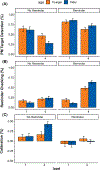Reminders eliminate age-related declines in prospective memory
- PMID: 39325414
- PMCID: PMC11781985
- DOI: 10.1037/pag0000844
Reminders eliminate age-related declines in prospective memory
Abstract
Prospective memory (PM)-the process of establishing intentions for future action and remembering to fulfill these intentions at the appropriate time-is necessary for many instrumental activities of daily living and for maintaining functional independence with increased age. Offloading PM demands onto the environment, such as setting a reminder alarm to take medication, offers an easy and effective way to mitigate age-related PM declines. However, a lack of basic knowledge about the cognitive and metacognitive processes that drive offloading decisions presents barriers to successful implementation. The present study addresses these issues by examining age differences in PM for offloaded (i.e., with reminders) and nonoffloaded (i.e., without reminders) intentions under low and high memory demands. With highly specific intentions that can be retrieved via bottom-up processes (Experiment 1), there were no age differences in PM without reminders, and younger and older adults equally benefitted from reminders under high memory load. With nonspecific intentions that require top-down attention for retrieval (Experiment 2), older adults had worse PM under high load without reminders. Critically, this age difference was eliminated with the use of reminders, likely due to increased reminder checking for older adults under high load. These findings suggest that offloading can circumvent cognitive capacity limitations and minimize computational effort to improve intention fulfillment in older adults. The theoretical and applied ramifications of these findings are discussed. (PsycInfo Database Record (c) 2025 APA, all rights reserved).
Figures



Similar articles
-
Optimal cognitive offloading: Increased reminder usage but reduced proreminder bias in older adults.Psychol Aging. 2023 Nov;38(7):684-695. doi: 10.1037/pag0000751. Epub 2023 Jun 8. Psychol Aging. 2023. PMID: 37289516
-
Age differences in strategic reminder setting and the compensatory role of metacognition.Psychol Aging. 2021 Mar;36(2):172-185. doi: 10.1037/pag0000590. Epub 2021 Feb 4. Psychol Aging. 2021. PMID: 33539150
-
Benefits from prospective memory offloading depend on memory load and reminder type.J Exp Psychol Learn Mem Cogn. 2023 Apr;49(4):590-606. doi: 10.1037/xlm0001191. Epub 2022 Oct 6. J Exp Psychol Learn Mem Cogn. 2023. PMID: 36201804
-
Outsourcing Memory to External Tools: A Review of 'Intention Offloading'.Psychon Bull Rev. 2023 Feb;30(1):60-76. doi: 10.3758/s13423-022-02139-4. Epub 2022 Jul 5. Psychon Bull Rev. 2023. PMID: 35789477 Free PMC article. Review.
-
Improving children's ability to remember intentions: a literature review on strategies to improve prospective memory during childhood.Psychol Res. 2023 Nov;87(8):2317-2335. doi: 10.1007/s00426-023-01834-8. Epub 2023 May 25. Psychol Res. 2023. PMID: 37231119 Free PMC article. Review.
Cited by
-
Cost avoidance underlies decisions to use prospective memory reminders.Mem Cognit. 2025 Feb 10:10.3758/s13421-025-01683-3. doi: 10.3758/s13421-025-01683-3. Online ahead of print. Mem Cognit. 2025. PMID: 39930086 Free PMC article.
-
Meta-analytic investigations of the effect of cognitive offloading on memory-based task performance and interindividual variability.Mem Cognit. 2025 Jun 11. doi: 10.3758/s13421-025-01743-8. Online ahead of print. Mem Cognit. 2025. PMID: 40500483
References
-
- Ball BH, Peper P, & Robison MK (in press). Experiments 1 and 2 [Data set]. https://osf.io/z9avt/?view_only=d85110af6ec841d8804f173e18e7e447
MeSH terms
Grants and funding
LinkOut - more resources
Full Text Sources
Medical

